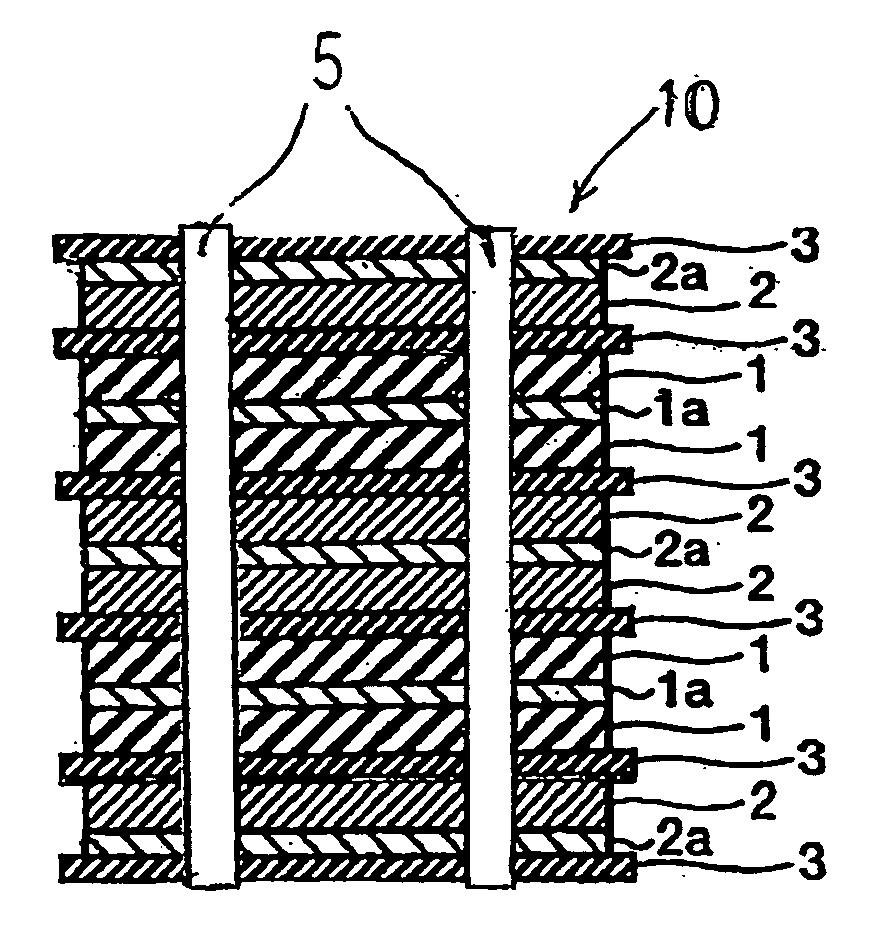Lithium ion capacitor
a technology of lithium ion and capacitor, which is applied in the field of lithium ion capacitor, can solve the problems of long time for lithium ions, substantial difficulty in increasing the number of lithium metals to be disposed, and disadvantages of industrialization, so as to reduce potential, increase capacitance, and increase the number of electrodes in the cell.
- Summary
- Abstract
- Description
- Claims
- Application Information
AI Technical Summary
Benefits of technology
Problems solved by technology
Method used
Image
Examples
example 1
Process for Producing Negative Electrode 1
[0095]A phenol resin molded plate having a thickness of 0.5 mm was put in a Siliconit electric furnace and subjected to a heat treatment by increasing the temperature at a rate of 50° C. / hour to 500° C. and further at a rate of 10° C. / hour to 660° C. in a nitrogen atmosphere thereby to synthesize PAS. The PAS plate thus obtained was pulverized with a disk mill to obtain a PAS powder. The PAS powder had a H / C ratio of 0.21.
[0096]Then, 100 parts by weight of the above PAS powder and a solution having 10 parts by weight of a vinylidene polyfluoride powder dissolved in 80 parts by weight of N-methylpyrrolidone were sufficiently mixed to obtain a slurry. This slurry was applied on one surface of a copper foil having a thickness of 18 μm in an amount of about 7 mg / cm2 as a solid content, dried and pressed to obtain a PAS negative electrode 1.
Process for Producing Positive Electrode 1
[0097]100 Parts by weight of a commercial activated carbon powder...
example 2
[0123]Two electrode units were obtained by laminating electrodes so that the positive electrodes and the negative electrodes faced at 20 faces in the same manner as in Example 1. For each electrode unit, 10 positive electrodes and 11 negative electrodes were used. The positive electrode active material weight is 1.4 times the negative electrode active material weight.
[0124]As a lithium electrode, two electrodes having a lithium metal foil (82 μm, 6.0×7.5 cm2, corresponding to 100 mAh / g) pressure bonded on one side of a stainless steel net having a thickness of 80 μm and one electrode having a lithium metal foil (164 μm, 6.0×7.5 cm2, corresponding to 200 mAh / g) pressure bonded on one side were obtained.
[0125]The lithium electrode having lithium metal of 164 μm pressure bonded was disposed between the two electrode units so as to face the electrode units, and the lithium electrodes having lithium metal of 82 μm pressure bonded on one side were disposed on the upper and lower portions ...
example 3
[0130]Five cells of film type capacitors were assembled (lithium metal in each cell corresponded to 400 mAh / g) in the same manner as in Example 2 except that a copper foil of 20 μm was used for the current collector of the lithium electrode.
[0131]20 Days after the cells were left to stand after assembled, one cell was decomposed, whereupon part of lithium metal in the lithium electrode disposed between the electrode units remained, but lithium metal in the lithium electrode disposed on each of the upper and lower portions disappeared. The cells were left to stand further for 20 days and then one cell was decomposed, whereupon lithium metal completely disappeared. Accordingly, it was judged that the negative electrodes were preliminarily charged with lithium ions so as to obtain a capacitance of 650 F / g per unit weight of the negative electrode active material. The capacitance of the negative electrode is 7.2 times the capacitance of the positive electrode.
[0132]In the same manner as...
PUM
| Property | Measurement | Unit |
|---|---|---|
| negative electrode potential | aaaaa | aaaaa |
| positive electrode potential | aaaaa | aaaaa |
| positive electrode potential | aaaaa | aaaaa |
Abstract
Description
Claims
Application Information
 Login to View More
Login to View More - R&D
- Intellectual Property
- Life Sciences
- Materials
- Tech Scout
- Unparalleled Data Quality
- Higher Quality Content
- 60% Fewer Hallucinations
Browse by: Latest US Patents, China's latest patents, Technical Efficacy Thesaurus, Application Domain, Technology Topic, Popular Technical Reports.
© 2025 PatSnap. All rights reserved.Legal|Privacy policy|Modern Slavery Act Transparency Statement|Sitemap|About US| Contact US: help@patsnap.com



